April 30, 2009
More on Particular & ToonIt
Noise Industries and Coremelt at NAB
 MacBreak has video interviews by Mark Spencer with Niclas Bahn, head of Noise Industries, and with Coremelt about their Mac OS-based visual effects extensions for After Effects and Motion. These interviews are nicely shot and have good audio but the segment with Noise Industrties had no demo or graphic examples.
MacBreak has video interviews by Mark Spencer with Niclas Bahn, head of Noise Industries, and with Coremelt about their Mac OS-based visual effects extensions for After Effects and Motion. These interviews are nicely shot and have good audio but the segment with Noise Industrties had no demo or graphic examples.
Flash Catalyst demo
April 29, 2009
PVC: Force an After Effects render Not to fail
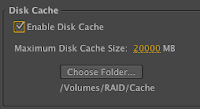 Mark Christiansen's daily tip is Force an After Effects Render not to Fail. Meant to cure the dreaded "Out of Memory" error caused by very large images, the solution (via Matt Silverman) is a combination of settings that starve AE of physical memory and forced it to page memory to disk.
Mark Christiansen's daily tip is Force an After Effects Render not to Fail. Meant to cure the dreaded "Out of Memory" error caused by very large images, the solution (via Matt Silverman) is a combination of settings that starve AE of physical memory and forced it to page memory to disk.Update: Mark's last daily tip is Force an After Effects Render to Fail (and Save!) on a Mac: Trigger a segmentation fault, win a prize: your project back.
Visual metadata
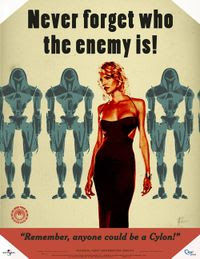 PrepShootPost ponders face recognition and says GIVE US MORE A.I. IN OUR N.L.E.
PrepShootPost ponders face recognition and says GIVE US MORE A.I. IN OUR N.L.E.His suggestions could already be on a feature request drawing board somewhere. As mentioned in a recent post, Adobe: 'The future of video is searchable', computer vision algorithms are being used in a variety of contexts to leverage facial recognition or face recognition and improve search results. VideoSurf and DigitalSmiths, iPhoto, Adobe's use of Idee's Pixsimilar as the visual search engine in Photoshop Elements 6, and smart phone advertising are all connected.
And since that AEP post, Google has gone beyond Picasa facial recognition and searching images by color to launch Similar Images. Beet.tv talked with Google about the future of image search last year, but here's what they have so far:
Adobe has shown some related stuff too, among stuff posted last December here in Adobe 'Infinite Images' sneak peek (explore that video at 62 minutes for an extra). Here's a different angle of the sneak peek at Adobe Max 2008; this one just shows "Content Intelligence Toolkit" and a bit on how it might be integrated with audio metadata:
Seeing this stuff integrated into Creative Suite apps would be exciting, especially for those who wondered why so much effort went into metadata in CS4. Assistant Editor from Philip Hodgetts and company does come to mind, so maybe we'll get project management features or something even more intelligent. Perhaps, but for now you can check out Assistant Editor and that beta app mentioned at PrepShootPost that helps with multicam clips, PluralEyes.
Make Sparkling Water at Home
Build car racing scene from photos in AE
28 Motion Graphics Blogs and Resources
 GoMediaZine posted a Topher Welsh list of Top 28 Best Motion Graphics Blogs and Resources which is enough to keep you busy for a month of a lunar year. GoMediaZine has a ton of their own resources on motion, web, and print -- including a dedicated section for After Effects tutorials. The list has a few surprises and some extra tidbits about sites that you may have visited a few times and lost track of. Happily, in a world now oozing with AE resources, Topher is forgiving of typos and bad grammar.
GoMediaZine posted a Topher Welsh list of Top 28 Best Motion Graphics Blogs and Resources which is enough to keep you busy for a month of a lunar year. GoMediaZine has a ton of their own resources on motion, web, and print -- including a dedicated section for After Effects tutorials. The list has a few surprises and some extra tidbits about sites that you may have visited a few times and lost track of. Happily, in a world now oozing with AE resources, Topher is forgiving of typos and bad grammar. One of the 28 resources listed hasn't been referred here, Digital-Tutors, which is 3D-oriented. It also has a dedicated section for free AE video tutorials (registration required).
One of the 28 resources listed hasn't been referred here, Digital-Tutors, which is 3D-oriented. It also has a dedicated section for free AE video tutorials (registration required). Another site of the 28 resources listed is Video Hive, which has plenty of AE-related stuff but doesn't tag the AE stuff separately.
Another site of the 28 resources listed is Video Hive, which has plenty of AE-related stuff but doesn't tag the AE stuff separately.Some resources could have made a fuller list of a 30 resources for a month in a solar year, sites like After Effects Help and Support or perhaps just After Effects region of interest by Adobe's AE Help caesar Todd Kopriva. Without cash or swag influence, one can note that the common use of the phrase "RTFM" indicates that company resources are not necessarily a given! [Update: perhaps Adobe.TV was picked as the Adobe presence]
 Also found recently (not that they'd make an imaginary AEP "best of" list yet) is another site, Forging Fire. They seem to have 2 categories of AE tutorials: theirs and "free" or external tutorials. In a handy turn, they tag the external tutorials by filter and function.
Also found recently (not that they'd make an imaginary AEP "best of" list yet) is another site, Forging Fire. They seem to have 2 categories of AE tutorials: theirs and "free" or external tutorials. In a handy turn, they tag the external tutorials by filter and function.
April 26, 2009
Adobe NAB tidbits: TV, Story, Strobe
Beet.TV notes other big news from Adobe -- Strobe -- the new video framework for building online video players. Of course back-end tools and the ability to play on TV could be an attractive-enough basis to create a standard. Probably not unrelated is news from NewTeeVee of the end of content syndication for downloadable media in Adobe Media Player. Hopefully Adobe will redo AMPs crippled UI to match or beat QuickTime Player, in addition developing of metadata and the backend. Here are video interviews from Beet.TV on Flash TV, Strobe, & partners:
April 24, 2009
See Particular 2 in action with Fxguide at NAB +ToonIt 2
 Fxguide has news from NAB, and their coverage of Autodesk, The Foundry (Nuke, also PVC on Nuke), RED, eyeon, and other higher end products might make you envious -- especially if you'd like more development of 3D in AE (see esp podcast #054) . More NAB news can be found via the headlines of CrispyFeeds.
Fxguide has news from NAB, and their coverage of Autodesk, The Foundry (Nuke, also PVC on Nuke), RED, eyeon, and other higher end products might make you envious -- especially if you'd like more development of 3D in AE (see esp podcast #054) . More NAB news can be found via the headlines of CrispyFeeds. The current fxguidetv video podcast, #055 is NAB2009 episode 2, which has a nice long demo of Trapcode Particular 2, a preview by The Foundry of a project that fixes material with rolling shutter, and more.
Update: FreshDV also looks at rolling shutter in an interview with a developer from the Foundry, via Discrete Cosine. And in addition to FreshDV's CrispyFeeds, The Editblog suggests also Mac Video and Mac Break for NAB video.
Update 2: FreshDV has video demos from NAB 2009 Video - Red Giant Particular 2 and ToonIt 2.
Preview samples of After Effects Studio Techniques
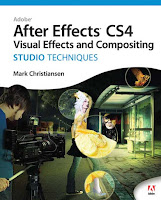 Peachpit and Mark Chrisitansen are offering a free preview chapter of After Effects Studio Techniques: Chapter 4. "Optimize the Pipeline," which discusses Multiple Compositions, Multiple Projects, Adjustment and Guide Layers, the Render Pipeline, and Project Optimization.
Peachpit and Mark Chrisitansen are offering a free preview chapter of After Effects Studio Techniques: Chapter 4. "Optimize the Pipeline," which discusses Multiple Compositions, Multiple Projects, Adjustment and Guide Layers, the Render Pipeline, and Project Optimization.Peachpit still has a previous excerpt available too, Using Keylight for Adobe After Effects CS4.
April 23, 2009
Adobe roto tool sighted on Toolfarm
 A few people mentioned seeing Adobe's new roto selection tool, including Toolfarm which has some pictures of a presentation of "Magic Matte." Similar technology was shown last year in a sneak peek of a futuristic Magic Wand-like tool, and related visual search & new compositing tech in another sneak peek at a MAX show this last winter.
A few people mentioned seeing Adobe's new roto selection tool, including Toolfarm which has some pictures of a presentation of "Magic Matte." Similar technology was shown last year in a sneak peek of a futuristic Magic Wand-like tool, and related visual search & new compositing tech in another sneak peek at a MAX show this last winter.Got Time?
Read more at Motionographer.
Videocopilot 'hot' Wired + American Stonehenge
Face off for tidbits
 Todd Kopriva takes the opportunity to wax philosophical on recent video tutorials in Face replacement with mocha from David Torno:
Todd Kopriva takes the opportunity to wax philosophical on recent video tutorials in Face replacement with mocha from David Torno:"Though it's easy to focus on the motion tracking aspects of these video tutorials, I think that they're just as valuable for the tidbits about rotoscoping, color correction, and time remapping---all of which are crucial for integrating one shot with another..."
There's more...
April 22, 2009
Plug-ins wont save you
 Eric Escobar says to "think before you filter" in his "Plug-ins wont save you" presentation at MacVideo from the FCPUG Supermeet at Macworld 2009. It's interesting if you want to find out what is evil about this picture.
Eric Escobar says to "think before you filter" in his "Plug-ins wont save you" presentation at MacVideo from the FCPUG Supermeet at Macworld 2009. It's interesting if you want to find out what is evil about this picture.
Ice cream and chess on Haight Street
Western, or Queen's, Chess is a modified variation of the game of strategy that traveled through India & Iran to Spain by about 1000 AD. Here's an ABC News backgrounder on the Hip Hop Chess Federation:
DaVinci Resolve running on a laptop
"More a technology demonstration and not a shipping product but interesting indeed. Of course a large part of a DaVinci system is hardware …."
Resolve is optimized for nVidia CUDA graphics acceleration.
April 21, 2009
New AE filters: Red Giant, Digieffects, Zax [updated]
Zaxwerks Serpentine is a new AE filter that creates path extrusions for 3D effects like moving film strips, shooting stars, animated marquee signs, swirling tubes, winding helixes, twisting extruded text, arrow pointers and self-tying ribbons. Ko Maruyama elaborates in his report at DMN:
"To those who know 3D terminology, you might consider Serpentine a Sweep NURBS object for After Effects. For those of you who don't know that terminology, consider an extrusion, but one that is not limited to a single direction, but instead moves along a path -- which could be anything from a straight line, to a curvy twisting, scaling shape that tumbles through space."
 Red Giant Software announced version 2 of both Trapcode Particular and ToonIt. ToonIt version 2 is just shipping. It attempts to go beyond basic cartoonification, with more controls and features like "natural media" effects, randomization, and built-in presets. Particular 2 will ship this summer or earlier. Already seen on screens everywhere this new version is said to have a big list of enhancements, including particle shading that responds to After Effects lights in 3D space.
Red Giant Software announced version 2 of both Trapcode Particular and ToonIt. ToonIt version 2 is just shipping. It attempts to go beyond basic cartoonification, with more controls and features like "natural media" effects, randomization, and built-in presets. Particular 2 will ship this summer or earlier. Already seen on screens everywhere this new version is said to have a big list of enhancements, including particle shading that responds to After Effects lights in 3D space.Digieffects is also showing 2 offerings shipping soon, Natural Forces and FreeForm AE. Natural Forces includes filters for weather effects, pyrotechnics, and atmospheric effects. FreeForm AE lets you manipulate a flat object into almost any shape using a mesh warp in 3D space.
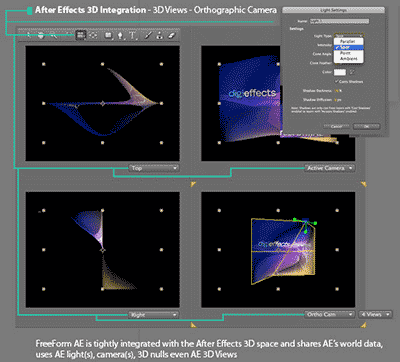
 Update: Chris & Trish Meyer have additional info on new filters from the NAB floor. Here's an excerpted list of part of the new features in Particular 2:
Update: Chris & Trish Meyer have additional info on new filters from the NAB floor. Here's an excerpted list of part of the new features in Particular 2: - custom particles can face in any direction (in version 1.5, custom particles always face the camera)
- particles can react to lights with full shading and depth of field and reflection maps
- new for all particle types is the Shadowlet option, which allows particles to cast shadows on themselves
- new particle type called Streaklet designed to easily create the long exposure light-streak look (think iPod ad)
- light falloff on particles, meaning particles that are far from a light source are not as brightly lit as those close to a light (remember that AE lights don’t inherently have a falloff based on distance, so Peder had to borrow that feature from his Lux plug-in)
- randomization option for sizing particles as well as a separate random seed for custom particles to determine which frame is used
- auto-orientation for shapes
- supports ortho rendering in 2-up and 4-up views, not just Active Camera
- Support for 32 bpc floating-point rendering
- Transfer Modes for stacking multiple instances, etc
- Adobe color picker
- Moved all parameters out of Options into regular sliders
- Increased max particles/sec to 1 million
- Visualization, offsets, & improved accuracy of Turbulence field
- Threading + Optimizations
- Many more improvements and bug fixes.
 Update 2: In an NAB survey Studio Daily notes, "Coremelt was showing their V2 update of its entire product line. With V2 the Coremelt plug-ins have moved from the Noise Industies FxFactory engine to their own engine. This new engine allows for some very intuitive controls that didn’t exist before." Toolfarm says users get "3 new FREE plugins; ImageFlow FX's MultiPop Forward, VeeYou V2's WV Oscilloscope and VeeYou V2's WV Voiceprint. You receive ALL 21 FREE plugins instantly when you install the 15 day trial of CoreMelt Complete V2!" Also, Steve Douglas has a review of CoreMelt's Complete V2 at Ken Stone's FCP website.
Update 2: In an NAB survey Studio Daily notes, "Coremelt was showing their V2 update of its entire product line. With V2 the Coremelt plug-ins have moved from the Noise Industies FxFactory engine to their own engine. This new engine allows for some very intuitive controls that didn’t exist before." Toolfarm says users get "3 new FREE plugins; ImageFlow FX's MultiPop Forward, VeeYou V2's WV Oscilloscope and VeeYou V2's WV Voiceprint. You receive ALL 21 FREE plugins instantly when you install the 15 day trial of CoreMelt Complete V2!" Also, Steve Douglas has a review of CoreMelt's Complete V2 at Ken Stone's FCP website.And speaking of Noise Industies, FxFactory offers over 300 visual effects plug-ins optimized for real-time performance on the Macintosh. The new update shown at NAB brings new products based on FxFactory: idustrial revolution Volumetrix 2, Motype 1.2, DVShade EasyLooks 2.5 and Boinx FxTiles 1.0 -- and includes performance enhancements to the blur and glow categories and 3 new plug-ins, PDF Animator, Perlin Noise generator and Alpha Merger.
Metallic Text in After Effects
 Layers Magazine has a video tutorial that shows you how to make text with a chrome look in AE. Author J. Schuh uses the layer context menu to enable Layer Styles > Show All on text. He selects Inner Shadow, Bevel and Emboss, Satin, Color Overlay, and Gradient Overlay (adjusting just the last style). Then he draws a wave in the Curves filter on an Adjustment Layer.
Layers Magazine has a video tutorial that shows you how to make text with a chrome look in AE. Author J. Schuh uses the layer context menu to enable Layer Styles > Show All on text. He selects Inner Shadow, Bevel and Emboss, Satin, Color Overlay, and Gradient Overlay (adjusting just the last style). Then he draws a wave in the Curves filter on an Adjustment Layer.In a previous tutorial, Chrome Logo in After Effects CS4, Schuh animated similar text with the Light Sweep filter and a 3D move.
H.264 primer for Adobe Media Encoder
 Kush Amerasinghe of Adobe has a new article at Adobe Developer Connection, H.264 for the rest of us, which includes "a layman's guide to video compression and F4V, an explanation of F4V-specific settings in Adobe Media Encoder and Adobe Flash Media Encoding Server, and a case study of estimating an acceptable bit rate for videos."
Kush Amerasinghe of Adobe has a new article at Adobe Developer Connection, H.264 for the rest of us, which includes "a layman's guide to video compression and F4V, an explanation of F4V-specific settings in Adobe Media Encoder and Adobe Flash Media Encoding Server, and a case study of estimating an acceptable bit rate for videos."See also Jan Ozer's recent Encoding options for H.264 video at the Adobe Developer Connection, the Adobe video and audio primers, and other AEP posts on H.264.
There are several hardware add-ons for H.264 compression, including Nvidia cards, the new Matrox CompressHD shown at NAB 2009, and the inexpensive Elgato Turbo .264 HD reviewed at Ken Stone's FCP website.
April 20, 2009
Sound Reacting 3D Waveform without 3rd Party Plugins
See Satya's blog Gutsblow for additional thoughts on his tutorials (and Presets). Here's samples of sound reacting ball waves and ethereal morphing:
more ethereal morphing from gutsbl'w on Vimeo.
April 17, 2009
Christiansen Birthday Special: 50% off RG Warp
 Mark Christiansen's Friday tip at PVC is on the After Effects filter Red Giant Warp. His post, Warped Friday, also notes that The Mark Christiansen Birthday Special gets you 50% off Warp – online purchases only, today, April 17 and tomorrow April 18 2009 with a coupon code.
Mark Christiansen's Friday tip at PVC is on the After Effects filter Red Giant Warp. His post, Warped Friday, also notes that The Mark Christiansen Birthday Special gets you 50% off Warp – online purchases only, today, April 17 and tomorrow April 18 2009 with a coupon code.Previous posts mentioning RGS Warp are here; they include Mylenium's Red Giant Warp 3D Tools and items on tracking and corner pinning.
Transferring software & plug-ins to a new computer
 Toolfarm posted what looks like helpful info: A Guide to Transferring Your Software & Plug-in Licenses to a New Computer. The article is organized by maker or distributor; comments and questions are welcome.
Toolfarm posted what looks like helpful info: A Guide to Transferring Your Software & Plug-in Licenses to a New Computer. The article is organized by maker or distributor; comments and questions are welcome.
Wider aspect: directional content adaptive scaling
 Future video-oriented versions of Content Aware Scaling might eliminate the need for "directional content aware scaling," if the problems encountered in scaling video can be solved.
Future video-oriented versions of Content Aware Scaling might eliminate the need for "directional content aware scaling," if the problems encountered in scaling video can be solved.It seems that the Food Network, HGTV, and other HD channels sometimes use a lens adapter or other technique to stretch SD content to HD. You can especially see the scaling in pans, where the center holds but the sides are stretched.
A post on the FCP-List mentioned that Teranex conversion and conditioning hardware executes a "center spread." Teranex (at NAB 2009, Booth SU5025) calls it "directional content adaptive scaling" and explains:
"Working with Turner Networks, Teranex developed a method of aspect ratio conversion using a non-linear anamorphic function. This technique, named FlexView, performs its aspect ratio conversion by leaving the picture information in the center of the image relatively undisturbed and then applies progressively more ‘stretch’ to the image as it gets closer to the edges. This process, while largely done in the horizontal domain also has a vertical component to help maintain correct geometry.
The basic premise is that most of the important content in a scene (the material that your eye is drawn to) is in the center of an image and the information on the edges is generally less important. Flexview leaves the center portion undisturbed and stretches the image most aggressively around the edges where there is less important material."
For more on this see the Flexview Application Note from Teranex.
 You can do this right now with a free Final Cut filter (via The Editblog) from Andy Mees called Andy’s Elastic Aspect.
You can do this right now with a free Final Cut filter (via The Editblog) from Andy Mees called Andy’s Elastic Aspect. And it seems like you might do this without too much trouble in After Effects or Premiere Pro with an appropriate gradient and a Displacement filter. Premiere with CUDA has better scaling quality, but the drawback is that the lower quality algorithms in popular software are unlikely to measure up to patented multipurpose hardware like Blackmagic Teranex.
For other options, see the nice thread on Creative Cow.
Note: It might even be possible to use the Protect options in Content Aware Scaling in later versions of Photoshop.
Shatter and disintegration: techniques for our time
 A few recent After Effects tutorials feature memes for our time: shatter and disintegration. Using the Shatter filter built into AE is Design a Breathtaking Body Shatter Effect by Lloyd Alvarez and expanding into another direction is After Effects: The Dark Knight by John Dickinson.
A few recent After Effects tutorials feature memes for our time: shatter and disintegration. Using the Shatter filter built into AE is Design a Breathtaking Body Shatter Effect by Lloyd Alvarez and expanding into another direction is After Effects: The Dark Knight by John Dickinson. Going beyond a previously noted 'Knowing' dead planet is Disintegration by Andrew Kramer, which uses displacement, turbulence and the built-in Particle World filter. The foundational tutorial by pioneer Brian Maffitt could not be located.
'Artists and their Apps' by Dr. Woohoo
 Dr. Woohoo, once known for his tools connecting Flash & After Effects, creates generative art that "fuses the intelligence of algorithms, the creative expressiveness of natural, organic media with behaviors found in natural systems." He's got a new article at Netdiver Magazine, Artists and their Apps, that looks at sources of inspiration.
Dr. Woohoo, once known for his tools connecting Flash & After Effects, creates generative art that "fuses the intelligence of algorithms, the creative expressiveness of natural, organic media with behaviors found in natural systems." He's got a new article at Netdiver Magazine, Artists and their Apps, that looks at sources of inspiration.
April 16, 2009
Jedi Mind Trick: Add a Console Log to AE
Overview of live video over the internet
 Here are some aging-as-we-speak notes done for a short survey of live video over the internet, as an alternative to investing in more costly and so more sexy satellite uplink systems. But then again more expensive systems may weather hurricanes and economic meltdowns a bit better.
Here are some aging-as-we-speak notes done for a short survey of live video over the internet, as an alternative to investing in more costly and so more sexy satellite uplink systems. But then again more expensive systems may weather hurricanes and economic meltdowns a bit better.Internet broadband services have proven capable in many live video events, including the 2009 Presidential inauguration, even if it did push the system to the edge (see below). Access to these services should expand in capacity at reduced prices over time with development of cable and VDSL broadband services. But there are many low-cost options available right now that should be putting pressure even on dedicated video conferencing businesses and services included in IPTV (Internet Protocol Television):
1) Chat software
Apple provides live video in iChat AV. And of course Skype can do video chat and now screen sharing, and is used by in broadcast TV by the major networks like CNN. Gmail is about to get HD options added to its video chat & it's not Adobe Flash, but something developed at Google.
2) Web services
There are a number of services doing lower end webcam live video that could become the YouTube of live video, and that includes YouTube as Google has let it be known they were developing live services for YouTube. This should be part of every social network in the near future. Here's a few current services:
Stickam
Blogtv
Justin.tv
Broadcaster.com
Nowlive.com
There were some earlier roundups at AEPortal News.
3) Mobile phones
Also slated for mass expansion is live video via mobile phones. I actually saw video from a Fall 2007 Adobe conference sent over a Nokia phone. Here's 2 overviews: Broadcasting live video from phone and Mobile video reporting increasingly important.
4) Flash web services
HD-quality video services can be built with Adobe production tools including Flash Media Live Encoder and Flash Media Server, although various services already leverage this technology for you.
Ustream.TV (http://www.ustream.tv/) has integrated Flash Media Live Encoder into its business to deliver high quality streams with interactive features. Ustream's FME Broadcast Console will enable users to:
* Start and stop their FME broadcasts
* Create FME broadcast recordings
* Add customized graphic overlays to their FME broadcasts
* Add polls
* Invite cohosts
Another internet service for live video is Mogulus, (update: now Livestream) which gives you the capability to easily broadcast live, 24/7 linear, and on-demand content for FREE. Mogulus PRO gives you the same features but adds a bundle of new features geared toward professional producers. Gannett had live hurricane coverage on the Mogulus platform in Fall 2008; see Live hurricane video and data..
5) CDNs
Whichever software encoding and server system is used (Flash, Silverlight / Windows Media, QuickTime), you'd have to have dedicated upload capacity or use a content distribution network (CDN), like Akamai at the high end. An aside, QuickTime Broadcaster can serve sessions for live video -- it works but the codecs weren't optimized previously so you need a good amount of dedicated bandwidth (a T1 could serve 7 content-hungry clients 320x240 10fps in 2006).
6) Compression and server/networking
Cisco is moving in, so it's a big market, but it's early to make sense of the role rack-mountable IPTV units for video compression and server/networking in many contexts. Various services use their software and server; see notes by Real World Video Compression and Matrixstream, and this on software encoding from Kulabyte.com.
7) Background
For more background, see naysayer Mark Cuban in The Great Internet Video Lie, and a rebuttal from Veoh, a streaming video service like YouTube.
There were some looks at the 2009 inauguration broadcasts by: Streamingmedia.com and Techcrunch.com. Not covered by Streaming Media was a reportedly a good inauguration effort by Move Networks, which partnered with CBS and Microsoft. Move offers a complete “signal to stream” delivery system not based on Flash or Windows Media, and is "not a CDN" as reported earlier. More info is here:
http://www.movenetworks.com/move-media-services/move-live-services
http://www.movenetworks.com/move-media-services/move-simulcode
http://www.beet.tv/2008/11/move-networks-a.html
Update: see also Cisco readying high end teleconferencing for consumers. And is Facebook Video Chat on the Way?
Update 2: note the previous post on Strobist's How to Improve Your Cheapo Webcam Picture Quality -- note that a better camera will work even better with better light.
Update 3: with the iPhone now doing live video streaming in December 2009, the Livestream CEO says that Live Video Will Comprise Half of Web Video Programming in Five Years.
April 15, 2009
Trapcode, Magic Bullet included with fxphd classes
Enrollment includes term access through July 31 to the Trapcode Suite and Magic Bullet Looks. Classes also include Cinema 4D, Maya 2009 Unlimited, PFTrack 5, Fusion 5, and Nuke 5 through VPN (Virtual Private Network). Here's a video overview of the offerings:
April 11, 2009
Inspiration via Digup & Motionographer F5
Motionographer also noted that "the brilliant new video-based design review site Digup.tv will be attending F5." On their blog Digup they say they're "an independent editorial project. It's a video documented review on digital design, accessible to non-specialists. Digup is lead by [CELLULES] a team of French interaction designers and documentary makers." Open just a month, Digup plans to release new interviews every 3 weeks and an in-depth investigation every 3 months. They also have a Vimeo channel and a Hello World trailer:
Update: the DVEIN F5 titles are up.
April 10, 2009
Adobe: 'The future of video is searchable'
"This new paper and demonstration show how to use Soundbooth to create an XML file that contains the metadata, rather than using After Effects scripting to convert cue points [discussed by Dan Ebberts without a demo app in February at the Adobe Developer Connection]."
The Delve player demo seems more attractive and interactive, but this is just the beginning; Google (video) and Microsoft (video) haven't made a splash quite yet.
Background on this use of metadata can be found in previous AEP posts like Metadata, search, analytics & monetization and Speech-to-Text metadata in web video. (which mentioned XMP Library for ActionScript on Adobe Labs which showed "the karaoke app").
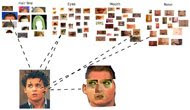 To see current search & discover approaches, you might have to dig through Reel SEO's handy list of video Search engines or a Wikipedia page to start. Interesting ideas on video search were discussed in More-Accurate Video Search, Video Search Challenge Isn’t Speech Recognition, It’s Content Owner Management, and in the NYT in Millions of Videos, and Now a Way to Search Inside Them (on Blinkx) and Zeroing In on Your Favorite Video Clips (on VideoSurf and DigitalSmiths use of computer vision algorithms).
To see current search & discover approaches, you might have to dig through Reel SEO's handy list of video Search engines or a Wikipedia page to start. Interesting ideas on video search were discussed in More-Accurate Video Search, Video Search Challenge Isn’t Speech Recognition, It’s Content Owner Management, and in the NYT in Millions of Videos, and Now a Way to Search Inside Them (on Blinkx) and Zeroing In on Your Favorite Video Clips (on VideoSurf and DigitalSmiths use of computer vision algorithms).By the way, Adobe uses something called Piximilar as the visual search engine in Photoshop Elements 6. Out on ahead is some more cool stuff; see Is Visual Search The Future Of Mobile Advertising? and this via the same site :

It almost seems like Skynet is real with these tiny smart cameras and Cylons and Terminators everywhere.
Update 2: (06/15) Richard Harrington follows up with Searchable Video with Creative Suite 4: Combine the power of Flash and Soundbooth to create searchable video.
Fake the tilt-and-shift look using After Effects
 In the latest edition of Digital Arts, Sam Hampton-Smith shows how to recreate the trendy tilt-shift lens effect in After Effects. Eventually this link will work, but for now you'll have to look at a hard copy: Fake the tilt-and-shift look using After Effects.
In the latest edition of Digital Arts, Sam Hampton-Smith shows how to recreate the trendy tilt-shift lens effect in After Effects. Eventually this link will work, but for now you'll have to look at a hard copy: Fake the tilt-and-shift look using After Effects. I'm sure a free AE tutorial will show up soon, but for now the outline re-described in the earlier post (and comments) Tilt-shift photography meme should do fine, if you have a soft touch on your gradient for the Lens Blur, Compound Blur or such filters. 2D Depth of Field, a 2006 video from VideoCoPilot, comes close but is missing something since it had other goals. According to a thread on the AE-List, further understanding can be gained by learning about view cameras, and by extension the Scheimpflug principle for changing the “plane of sharp focus.”
I'm sure a free AE tutorial will show up soon, but for now the outline re-described in the earlier post (and comments) Tilt-shift photography meme should do fine, if you have a soft touch on your gradient for the Lens Blur, Compound Blur or such filters. 2D Depth of Field, a 2006 video from VideoCoPilot, comes close but is missing something since it had other goals. According to a thread on the AE-List, further understanding can be gained by learning about view cameras, and by extension the Scheimpflug principle for changing the “plane of sharp focus.”Update: Topher Welsh has a tutorial for AE, though it's not the first one:
Update 2: Maltaannon, Vailancio Rodrigues, and AE Tuts added Tilt-Shift tutorials for After Effects; this link connects the rest of the other info on this effect.
Christiansen's April AE tips so far

- Linear Blending at Any Color Depth in After Effects
- Send After Effects 3D animation data to Cinema 4D (or Maya, Max, Lightwave…)
- Apply Color Adjustments to RED QuickTimes
- Use iChat to McGyver Back to your Mac
- Locate Missing Effects in After Effects CS4
- Debug QuickTime Preferences
- Create Cinematic Motion Blur in After Effects (and in life)
- Render Faster & Smarter in After Effects with BG Renderer
April 8, 2009
Particle > Form > SHIFT.chroma
Youssef Sarhan explains a bit how he used Trapcode Form in After Effects to create SHIFT.chroma (via), which seems to riff off Maltaannon's House of Form. There's no rule that you'd have to use Form's particles -- but it might be harder going for the same look without it. There some more cool Form videos recently linked on the Trapcode Gallery. Here's Youssef's video, which is HD at Vimeo:
Other nice random but unparticle inspiration can be seen at Feed (What’s Happening/Now) and Motionographer (Steel Life). And click below to see a better view of some different kind of particles from India's Festival of Colors:
April 7, 2009
SF Cutters April 28: Motion, Flash video, more
 The SF Cutters last meeting at Adobe is on April 28th in San Francisco.
The SF Cutters last meeting at Adobe is on April 28th in San Francisco.RSVP is required; $15 online includes raffle. Full details and registration can be found here. Doors open at 6:30; presentations include:
- Mark Spencer on Motion 3 Templates
- John Skidgel now at Google on Flash Video
- Jai Noire, Independent Shooter/Editor will show reel
- Adobe will provide a NAB wrapup (more details to come)
Grayscale Shootouts
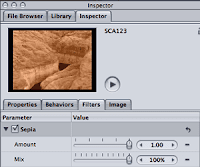 Chris & Trish Meyer of Crish Design (cybmotion.com) have a short survey at Artbeats of the best effects in After Effects, Motion, and Final Cut to convert color footage to black & white, Grayscale Shootout. It's a somewhat fuller version of the note posted earlier on PVC, A Rose-Colored Tint, by Any Other Name.
Chris & Trish Meyer of Crish Design (cybmotion.com) have a short survey at Artbeats of the best effects in After Effects, Motion, and Final Cut to convert color footage to black & white, Grayscale Shootout. It's a somewhat fuller version of the note posted earlier on PVC, A Rose-Colored Tint, by Any Other Name.Conversions like this have caused a lot of stress for Photoshop users in the past, as seen the long list of methods at Retouch Pro. Oddly, there's not many specifics from Photoshop Channel Chops (by the Calculations champion David Biedny et al) mentioned nowadays.
There are several ways to convert to grayscale in Photoshop, including using an individual RGB channel, the Lightness channel in Lab mode, a Channel Mixer Adjustment Layer, Hue/Saturation Adjustment Layers (use two and lower Saturation on to then adjust Hue on bottom), and so forth. Changing the mode to Grayscale (Image> Mode> Grayscale) in RGB uses a mix of 59% of the Green channel, 30% of the Red channel, and 11% of the Blue channel, while the Black and White Adjustment control does 40, 40, 20 and let's you refine the mix. Various aspects of this are discussed in an Adobe article, Choosing a preferred set of tones.
Russell Brown outlined the newer and apparently preferable Photoshop CS3/CS4 method of using the Black and White Adjustments in his movie Converting Color to Black-and-White. Martin Evening also has a video tutorial for conversion in Lightroom, though there's probably something newer.
Update: Richard Harrington has a related video on Adobe TV.
Update 2: Photoshop News has a tutorial in QuickTime, Advanced color to black and white conversion: "Using color channels as grayscale layers means you can use layer masks to alter the grayscale conversion and allows you to optimize for the best possible result. The technique allows shows how to re-convert your grayscale image back to a color image for the purposes of color toning."
Update 3: John Nack's Photoshop + Lightroom = Killer B&W from March 2008 has some extra info, including Kelly Castro's method for getting eyes to "pop:"
METHOD:
- Open a portrait image in Photoshop
- Choose Window > Layers (F7)
- Command + = (zoom in on the eyes)
- Shift + Command + N (new layer)
- Press X (switch foreground color to white)
- Press G (gradient tool)
- Open Gradient Picker in the Tool Options Bar and select "Foreground to Transparent"
- Select "Radial Gradient" in the Tool Options Bar
- Mode: Normal / Opacity: 100% / Reverse: unchecked / Dither & Transparency: checked
- Place your cursor over one of the subject's eyes
- Click in the center of the pupil and drag to the edge of the iris
- Repeat for second eye
- In the Layers palette, set the blending mode to "Overlay"
- Adjust the layer opacity to taste
- Command + E (flatten layers)
- Command + S (save)
RESULT:
A portrait with more impact.
Update 4: There's yet another tutorial for Lightroom; this one from PhotoshopCafe:
April 6, 2009
Podcasting design, production, distribution
 The PVC Pipeline | Distribution e-mail newsletter is out and among the features is Podcasting Design by Alex Lindsay. The article discusses goals, designing & structuring a podcast, gear & software, and publishing services.
The PVC Pipeline | Distribution e-mail newsletter is out and among the features is Podcasting Design by Alex Lindsay. The article discusses goals, designing & structuring a podcast, gear & software, and publishing services.Alex's company dvGarage has been doing video training for quite awhile now, and Alex shares lessons learned over the last 8 years of producing online video. The DVG volunteer crew Pixel Corps now produces about 80 episodes a month (in 6-8 formats), so hopefully this article will just be the first.
Adobe Forums facelift
 Adobe Forums > Adobe After Effects has had a facelift.
Adobe Forums > Adobe After Effects has had a facelift.Perhaps it could use a information re-design too -- it's still a bit of a dogpile. John Nack ran down the changes and got some feedback as well. Stephen Muratore has a slightly fuller list of improvements.
Update: Todd Kopriva adds a good deal of advice on using the Adobe Forums, and kindly notes Mylenium posts have more. Still they seem a bit wild West...
Calculated dishonesty and a 'Green Collar' stimulus
 A few days ago Bill Moyers interviewed economics professor William K. Black, who says that 'it was more than greed and incompetence that brought down the U.S. financial sector and plunged the economy in recession ... at the very center of mortgage collapse, creating triple-A rated bonds out of "liars' loans" — loans issued without verifying income, assets or employment — was a fraud, and the banks knew it.'
A few days ago Bill Moyers interviewed economics professor William K. Black, who says that 'it was more than greed and incompetence that brought down the U.S. financial sector and plunged the economy in recession ... at the very center of mortgage collapse, creating triple-A rated bonds out of "liars' loans" — loans issued without verifying income, assets or employment — was a fraud, and the banks knew it.'Black says the fraud had 3 stages: "the way that you do it is to make really bad loans, because they pay better. Then you grow extremely rapidly, in other words, you're a Ponzi-like scheme. And the third thing you do is we call it leverage. That just means borrowing a lot of money, and the combination creates a situation where you have guaranteed record profits in the early years. That makes you rich, through the bonuses that modern executive compensation has produced. It also makes it inevitable that there's going to be a disaster down the road."
Black also comments on the foxes guarding the hen house; see this excerpt or the entire QuickTime version at Moyers Journal:
 And via Glenn Greenwald in his multisource summary "Larry Summers, Tim Geithner and Wall Street's ownership of government," is yet another cautionary view. Offered by Simon Johnson, a professor at MIT and former chief economist at the International Monetary Fund, is "The Quiet Coup" at The Atlantic monthly:
And via Glenn Greenwald in his multisource summary "Larry Summers, Tim Geithner and Wall Street's ownership of government," is yet another cautionary view. Offered by Simon Johnson, a professor at MIT and former chief economist at the International Monetary Fund, is "The Quiet Coup" at The Atlantic monthly:"The crash has laid bare many unpleasant truths about the United States. ...the finance industry has effectively captured our government—a state of affairs that more typically describes emerging markets, and is at the center of many emerging-market crises. If the IMF’s staff could speak freely about the U.S., it would tell us what it tells all countries in this situation: recovery will fail unless we break the financial oligarchy that is blocking essential reform. And if we are to prevent a true depression, we’re running out of time."
<Update\: Elizabeth Warren's 8-minute video summary of a congressional panel report, via Mike Whitney /update end>
Despite the morass, there are plenty of options -- it's not like the country has been destroyed in a Mongol Invasion like medieval Baghdad. As noted earlier among other good news, SF Bay's Van Jones was appointed Special Advisor for Green Jobs, Enterprise and Innovation by the White House. Jones advocates another type of stimulus -- investments in people and green infrastructure rather than bailouts.
Amazon doesn't let you embed their video, so they won't be able to try to get you to buy the Van Jones book The Green Collar Economy: How One Solution Can Fix Our Two Biggest Problems. Here's 2 videos highlighting Jones' ideas:
The Green Collar Economy - Van Jones of the Center for American Progress @ Yahoo!7 Video
Update: Roubini and Taleb discuss the crisis...








